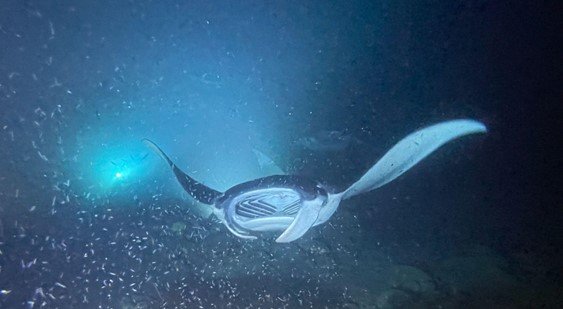
Manta rays are like the gentle giants of the ocean, gliding gracefully through the water as they filter feed on plankton. Their unique way of life and delicate bodies make them particularly vulnerable to the impacts of climate change. Just like a delicate balance in an ecosystem can be thrown off by a single change, the health of manta rays is tied closely to the health of their marine environment. When the waters are warm and the ocean is stable, manta rays thrive. But as temperatures rise and habitats change, these magnificent creatures face threats that could disrupt their lives in significant ways.
Let’s break down how climate change impacts manta rays, focusing on a few crucial areas: water temperature, food supply, habitat degradation, and marine biodiversity.
Rising Water Temperatures
Water temperature plays a massive role in the lives of manta rays. These creatures are ectothermic, which means their body temperature is directly influenced by their environment. As the ocean warms, it can lead to stress for manta rays. Picture yourself on a hot summer day—if you’re overheating, you become sluggish and uncomfortable. The same goes for manta rays when the water temperature rises.
In warmer waters, manta rays may migrate to cooler areas, changing their traditional feeding and breeding grounds. This could force them into competition with other species for space and food. Additionally, warmer waters can lead to increased occurrences of diseases, which can further threaten the already vulnerable populations of manta rays.
Food Supply Disruption
Manta rays primarily feed on tiny organisms called plankton, which thrive in specific environmental conditions. As climate change alters sea temperatures and currents, it can disrupt plankton populations. Imagine being at a buffet where the food runs out just as you arrive. That’s akin to what happens when the plankton dwindles due to environmental shifts.
If manta rays can’t find their food, they may struggle to survive or reproduce. This could lead to a decline in their populations. The balance of their diet and the availability of their food sources is crucial for their long-term survival. If conditions continue to change, we might witness significant shifts in the behavior and distribution of these intelligent creatures.
Habitat Degradation
Coral reefs are essential habitats for many marine species, including manta rays. Unfortunately, coral reefs are under severe threat from climate change. Rising sea temperatures can cause coral bleaching, a process where corals lose their vibrant colors and essential algae. This not only impacts the corals themselves but also the entire ecosystem that depends on them.
Manta rays often rely on coral reef environments for feeding and protection. As these reefs decline, manta rays lose valuable habitats. If they can’t find places to hide from predators or suitable feeding grounds, it could lead to a drop in their populations. Protecting coral reefs isn’t just about preserving pretty scenery; it’s about maintaining the health of entire ocean ecosystems, including manta rays.
Marine Biodiversity Loss
Climate change doesn’t just affect manta rays directly; it impacts a whole array of marine life. As ocean temperatures rise and acidification occurs, many species struggle to adapt. Think of it like a domino effect—when one species is impacted, others follow suit. Manta rays rely on a healthy ecosystem filled with diverse species to survive.
With the loss of biodiversity, the ocean becomes less resilient to stressors. This could lead to shifts in the food web, affecting all creatures that depend on various species for survival, including our beloved manta rays. The reduction in biodiversity can also mean fewer healthy habitats, making it even harder for these majestic creatures to thrive.
Conservation Efforts and Hope
Despite the challenges posed by climate change, there is hope. Conservation efforts focused on protecting marine environments can make a difference for manta rays. Organizations worldwide work tirelessly to create marine protected areas, raise awareness, and engage in sustainable fishing practices.
By reducing pollution, protecting habitats, and promoting sustainable tourism, we can help ensure a brighter future for manta rays. These efforts require collective action—governments, communities, and individuals all play a part. Every small step counts, whether it’s an initiative to clean up local beaches or supporting organizations dedicated to marine conservation.
Understanding the Importance of Manta Rays
Manta rays are not just beautiful creatures; they also play a vital role in the ocean ecosystem. Their behavior helps regulate plankton populations and contributes to nutrient cycles in marine environments. When we protect manta rays, we’re also protecting the larger health of our oceans.
Understanding the importance of manta rays can fuel conservation efforts. When communities recognize their value, they’re more likely to engage in protective measures. Education plays a key role in this, whether through school programs, awareness campaigns, or community events. The more people know about these gentle giants, the more likely they are to support efforts that protect them.
Climate change is a pressing challenge for our planet, and its effects ripple through the ocean, impacting creatures like the manta ray. From rising temperatures to habitat loss, these issues require attention and action. However, there’s hope. By joining forces in conservation efforts, we can work to protect not just manta rays but the entire marine ecosystem they call home.
Keeping our oceans healthy is essential for the future of marine life, including the majestic manta ray. It’s a journey that requires empathy, awareness, and collective action. Let’s take these steps together for a better future, ensuring that these magnificent creatures continue to glide gracefully through our oceans for generations to come.
